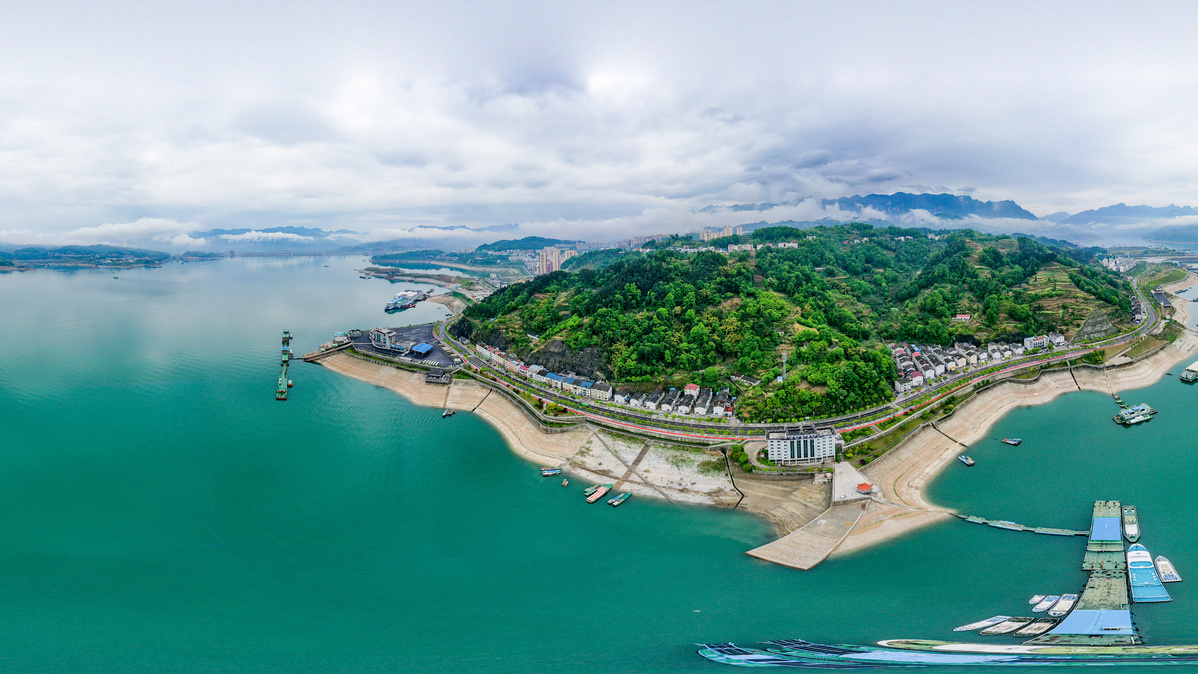
Ships dock at a tourism port on the Yangtze River in Zigui, Hubei province, last month. LEI YONG/XINHUA
The COVID-19 pandemic still raging around the globe is a wakeup call on many fronts, not least on how the well-being of humans, animals, and ecosystems is inextricably interconnected.
A case in point is the Yellow River basin, an ecological corridor running through nine provinces and autonomous regions in China. Known as the "Mother River" and cradle of Chinese civilization, the Yellow River is home to about 150 million people.
Yet prone to natural disasters and impacts from climate change, land use and human activities, the Yellow River basin is struggling to maintain its ecological function and support the lives that are dependent on it. The basin feeds about 12 percent of China's population and supports 14 percent of the country's national gross domestic product.
In a rather unanticipated way, COVID-19 has provided a glimmer hope and a silver lining for a more sustainable future in the Yellow River basin. From January to March 2020, water quality has improved considerably, according to the latest statistics from the Ministry of Ecology and Environment. The proportion of good water quality (category I-III) in the Yellow River has reached 78 percent in 2020, up 6.5 percent year-on-year, with the inferior category V decreasing 3.8 percent and dropping to 9 percent. Better surface water in the main industrial centers can have a positive impact on the health and well-being of the communities living nearby.
Using the Yellow River basin as an example, the post-COVID-19 future presents an opportunity to embrace this change and spur a green economic recovery. This will require policies to mitigate future health threats, but also concerted action to halt biodiversity loss, sustain nature, and keep climate change in check. In short, we must build back better. In the process, greater consideration should be given to ecological and environmental protection as a buffer to reduce anthropogenic pressures and minimize the likelihood of future public health emergencies, such as COVID-19.
For the national and provincial governments and policymakers in China, these lessons are particularly timely, since they are stepping up wider efforts to enhance ecological protection and high-quality development. Healthy ecosystems can support economic growth, societal wellbeing and climate stabilization. A new nature-positive approach is needed to drive green economic recovery that balances the health of the environment and humans, especially the most vulnerable groups.
As China looks to the Yellow River basin as an opportunity to pursue a greener and more sustainable approach to stimulating economic activity, here are some key policy actions to achieve high-quality growth.
First, the environment should be at the core of the "One Health Approach". This integrates human, animal, and environmental health, but is often overlooked. A greater emphasis on their interactions and environmental protection in the post-COVID-19 response will be fundamental for maintaining food security, food safety, and health at the local, regional, and global levels
Second, a holistic and integrated ecosystem management is needed. A coordinated and integrated approach encompassing social, economic, disaster risk management and environmental issues is also needed. As one of the most hydrologically complex rivers, it is important that a basin-wide multisector master plan is prepared to enable comprehensive planning in the basin.
Third, policies and institutions are the "enablers". Strong policy and regulatory frameworks are needed to build the momentum for changed mindsets and environmentally sustainable results in the basin. Wider use of advanced and innovative mechanisms such as water trading and eco-compensation mechanisms can drive water use efficiency, while promoting adoption of modern technologies in agriculture and industry sectors.
Fourth, a green growth model is the way forward. Actions must be focused on pollution reduction, innovation, productivity enhancement, clean energy, environmentally friendly technology, green infrastructure, and green finance. The government's fiscal stimulus support as well as new green financing models should target these areas and take precedence over traditional models.
Fifth, the private sector has a catalytic role to play. The private sector can leverage government investments in natural capital to achieve stronger environmental protection and sustainable green development. Public-private partnerships can promote a win-win scenario balancing poverty reduction and environmental protection.
Meanwhile, green financing mechanisms can help drive new conservation financing to stimulate investment and support green development and biodiversity protection while reducing carbon footprints. An example is Alibaba Ant Forest, China's largest private sector tree-planting initiative, which promotes greener lifestyles by inspiring users to reduce carbon emissions in exchange for credit that can be converted into trees. Alibaba leverages the power of digital technology to alleviate poverty and improve the lives of local people.
After COVID-19, the interlinkages between biodiversity and habitat loss, illegal wildlife trade and the resilience of interconnected supply chains in the global economy can no longer be overlooked. The post-COVID-19 economic recovery will require strong leadership together with a new level of cooperation and coordination at the local, regional and global levels.
High-quality green development is a positive way forward, providing multifaceted benefits and new opportunities to foster knowledge and share experiences while delivering global and regional public goods. Using COVID-19 as an accelerator for ongoing structural changes and amelioration of water quality standards can save human and planetary health from future crises.
The author is director general of the Asian Development Bank's East Asia Department. The views don't necessarily represent those of China Daily.


